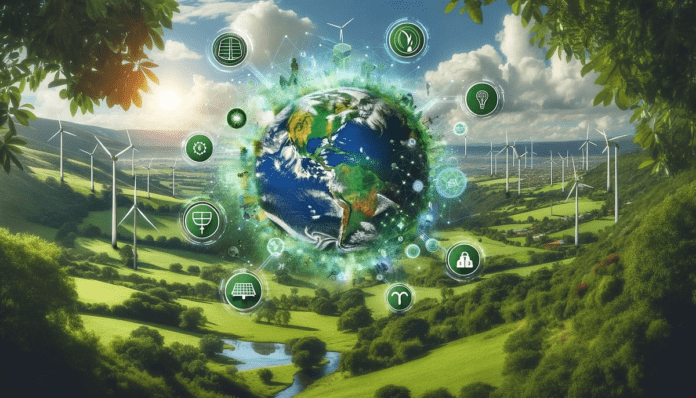Worsening anxieties about climate and environmental degradation impel humanity into a new and creative way in which we imagine interacting with this planet. While the heart of this change hinges on green technologies, innovative techniques designed to abate our harm to the natural environment while working toward sustainable growth, from re-energization systems to methods of manufacturing sustainably, transform industries and produce a roadmap that is cleaner and greener.
1. Solar Power: The Beacon of Renewable Energy
Solar energy remains one of the cornerstones of green technology. Photovoltaic cells, particularly perovskite solar panels, have seen improvements in efficiency and cost. It is now possible for solar power to reach not only homes but also industries, hence facilitating a large-scale shift from fossil fuels to renewable energy.
On the other hand, solar-powered equipment, including portable chargers and solar lights, have turned out to become integral parts of daily life. An investor keen on the increase in renewable sources can utilize a stock screener to identify solar innovation leaders.
2. Wind Energy: Capturing Nature’s Power
Wind energy has exploded over the years due to technological innovations aimed at maximizing turbine efficiency. Offshore wind farms that capture stronger and more consistent winds are increasingly becoming a favorite method of tapping wind power.
In addition, compact and less obtrusive alternatives are emerging with vertical-axis wind turbines and bladeless wind turbines. With these innovations, wind energy becomes feasible even in urban environments, reducing greenhouse gas emissions while providing clean energy at a competitive cost.
3. Green Buildings: Smart and Sustainable
Green building technologies minimize the adverse environmental impacts associated with construction and operation. These include smart energy management systems, water recycling setups, and green construction materials like bamboo and recycled steel.
Net-zero energy buildings are increasingly being embraced globally as they produce as much energy as they consume. IoT devices in such buildings optimize energy usage, minimize waste, and offer a healthier living environment.
4. Electric Vehicles (EVs): Paving the future
Electric cars are no longer a niche; they are becoming a global revolution. Improving battery technology, such as solid-state batteries for EVs, has made this option more economic, efficient, and sustainable.
More than that, the V2G technology makes EVs become a storage unit of energy. That is how the power grid can be stabilized. Since major automobile manufacturers have announced the end of internal combustion engines, it will be an EV-dominated mode of transportation.
5. Carbon Capture and Storage (CCS)
Some of the most imaginative green technologies are carbon capture and storage, or capturing carbon dioxide emissions from industrial processes and putting them underground. Improved CCS technologies, such as direct air capture (DAC), can capture CO₂ directly from the atmosphere, a key tool that may reverse the course of climate change. There are many industries, including both energy and manufacturing, exploring the use of CCS to meet stringent carbon-reduction goals.
6. Sustainable Agriculture: Feed the Planet Responsibly
Agriculture is one of the biggest greenhouse gas emitters and is gradually seeing a green revolution. Fueled by AI and IoT, precision farming is optimizing resources with soil health, weather patterns, and crop requirement analysis.
Water and land use are lessened: Hydroponic and vertical farms are the perfect solutions for urban farming because the crops are produced in controlled environments indoors.
New products include lab-grown meats and plant-based proteins that cut the footprint for food as well.
7. Waste Management and Recycling
Waste management is another green technology revolution. The most up-to-date recycling techniques now break down plastics into raw materials, thereby offering infinite reutilization.
Artificially intelligent smart bins that can distinguish between types of waste can recycle the same efficiently. Firms are even exploring the possibilities of upcycling-that converting waste to products of a greater value-thereby realizing the circular economy.
8. Green Hydrogen: The Fuel of the Future
Green hydrogen, which is fueled by renewable energy, is becoming a clean alternative to fossil fuels. This versatile energy source can be used for power generation, industrial processes, and even fuel for hydrogen-powered vehicles.
The world is investing in green hydrogen infrastructure, which indicates its potential in decarbonizing hard-to-electrify sectors such as aviation and shipping.
9. Marine and Ocean Tech: Save the Blue Planet
Oceans are crucial for the well-being of the planet, and green technologies play a crucial role in conserving marine ecosystems. Inventions such as floating solar farms and tidal energy generators can capture renewable energy from oceans while disrupting the environment less.
Underwater monitoring of ocean health, mapping of marine biodiversity, and monitoring of pollution sources are conducted using marine drones and underwater robots, ensuring that this blue planet continues to be sustainable for the coming generations.
10. Biodegradable Materials: Waste Reduction
Plastic is one of the most serious issues in the contemporary world. With green tech innovations, people are experimenting with algae, fungi, and plant-based polymers that can replace plastic.
These break down naturally and do not leave any toxic residue. They are already being used in packaging, textiles, and construction. Biodegradable alternatives are urgently needed to help solve the waste crisis of the world and reduce its reliance on landfills.
The Role of Technology in Scaling Green Solutions
Technology will be the key enabler in scaling green innovation. Big data analytics, AI, and machine learning are enabling solutions that are both precise and efficient across industries. Predictive analytics optimizes renewable energy grids, while blockchain ensures the transparency of carbon credit trading.
Tools used may include stock screeners, which could help investors focus on companies that are a step ahead with green technology. This would lead to an effective, sustainable economy alongside financial growth.
Challenges and Opportunities
Though green technology holds great promise, it must overcome some issues, such as high initial costs, regulatory barriers, and the public’s unwillingness to change. Collaborative efforts among governments and the private sector could easily provide incentives in place of effective policies and foster innovation.
However, the opportunities outweigh the challenges. Green technology mitigates environmental issues, creates jobs, stimulates economic growth, and improves quality of life.
Conclusion
Green technology represents the intersection of innovation and sustainability. From renewable energy systems to biodegradable materials, these advancements are paving the way for a cleaner, greener planet.
By embracing and investing in such technologies, we will ensure sustainability for generations. Tools like a stock screener will help track and support those companies driving the green tech revolution through this transformative period, making it easier for individual and organizational stakeholders to contribute toward global sustainability.






